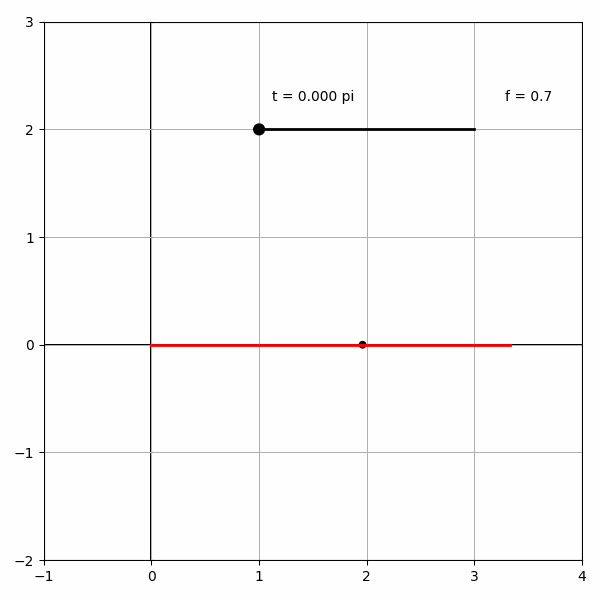Complex chain (30/07/21 Classic)
What is the locus of the tips of all chains that satisfy the below properties?
- each link is a fraction $f$ of the previous
- the angle between each pair of adjacent links is constant throughout the chain
- the first chain link is locked in place
This is annoying to solve trigonometrically, so we turn to the complex numbers as a representation of the 2D plane. The length of the $(n+1)$th link is $f^n$, while its orientation angle relative to the first link is $nt$ for some arbitrary parameter $t\in\mathbb{R}$. So, we represent the $(n+1)$th link by a complex number $f^n e^{int}$ which describes its magnitude and orientation in the complex plane.
(Note that this complex representation means the first link is fixed to lie on the real axis between $0$ and $1$, without loss of generality. Also, the actual angle between the first two links is $|t-\pi|$ and not $t$).
Hence, the tip of the chain, $z(t)$, is the infinite sum of these complex chain links: \[\begin{align*}z(t)&=\sum^\infty_{n=0}f^n e^{int}\\&=\frac{1}{1-f e^{it}}\end{align*} \]noting the use of the convergent geometric series formula, which is valid as $|f e^{it}|=f<1$.
To determine the shape traced by $z(t)$, we intepret the equation \[z(t)=\frac{1}{1-fe^{it}}\]as a Möbius transformation of the complex number $e^{it}$ to the number $z(t)$. One property of Möbius transforms is that they map circles to either lines or circles. Indeed, the set of points $\{e^{it}\}$ is the unit circle; hence, its transform $\{z(t)\}$ must also be a circle. (Note that it cannot be a line because lines diverge to infinity on the complex plane, but we know that $z(t)$ must be finite as the infinite series above is convergent for $f<1$.)
As the shape is a circle, there must exist a centre point $c\in\mathbb{C}$ and a radius $r\geq 0$ such that $$|z(t)-c|=r$$
To determine the centre point, we use the fact that$$z(t)^*=z(-t)$$which implies the $\{z(t)\}$ circle is reflection-symmetric across the real axis, as every $z(t)$ has a complex conjugate partner on the other side of the real axis. Reflection symmetry lines for circles are diameters, so the real axis must contain a diameter. Given that $z(0),z(\pi)\in\mathbb{R}$, the line connecting $z(0)$ and $z(\pi)$ must be a diameter, and so the centre point must be their average:
$$\begin{align*}c&=\frac{1}{2}\Big(z(0)+z(\pi)\Big)\\&=\frac{1}{2}\Big(\frac{1}{1-f}+\frac{1}{1+f}\Big)\\&=\frac{1}{1-f^2}\end{align*}$$
To verify that $c=\frac{1}{1-f^2}$ and to find the radius, we check:
$$\begin{align*}|z(t)-c|&=\Big|\frac{1}{1-fe^{it}}-\frac{1}{1-f^2}\Big|\\&=\Big|\frac{(1-f^2)-(1-fe^{it})}{(1-fe^{it})(1-f^2)}\Big|\\&=\Big|\frac{f(e^{it}-f)}{(1-fe^{it})(1-f^2)}\Big|\\&=\frac{f}{1-f^2}\cdot\frac{|e^{it}-f|}{|1-fe^{it}|}\\&=\frac{f}{1-f^2}\cdot\frac{|1-fe^{-it}|\cdot|e^{it}|}{|1-fe^{it}|}\\&=\frac{f}{1-f^2}\end{align*}$$
(The last line is true because $1-fe^{-it}$ and $1-fe^{it}$ are complex conjugates of each other, and hence have the same magnitude.)
So, we have $|z(t)-c|=\frac{f}{1-f^2}$, which is constant. This is the equation for a circular arc centred on $c=\frac{1}{1-f^2}$ with radius $r=\frac{f}{1-f^2}$.
Returning to the 2D geometry, we conclude that if (without loss of generality) the chain's first link is anchored the origin and oriented along the $x$-axis, then the chain's tip traces out a circle centred at $\big(\frac{1}{1-f^2},0\big)$ with radius $\frac{f}{1-f^2}$.
Below is an animation for $f=0.7$, noting the $2\pi$-periodicity of $z(t)$:

Addendum
After I posted this solution on Twitter, @EricMentzell pointed out that if we assume the links cannot cross, then the chain might become halted at some point:
For f = 0.7, at link angle t=0.7532 pi, the links all touch, and the chain can't move anymore: pic.twitter.com/BvbIIn06iL
— Eric Mentzell (@EricMentzell) August 2, 2021